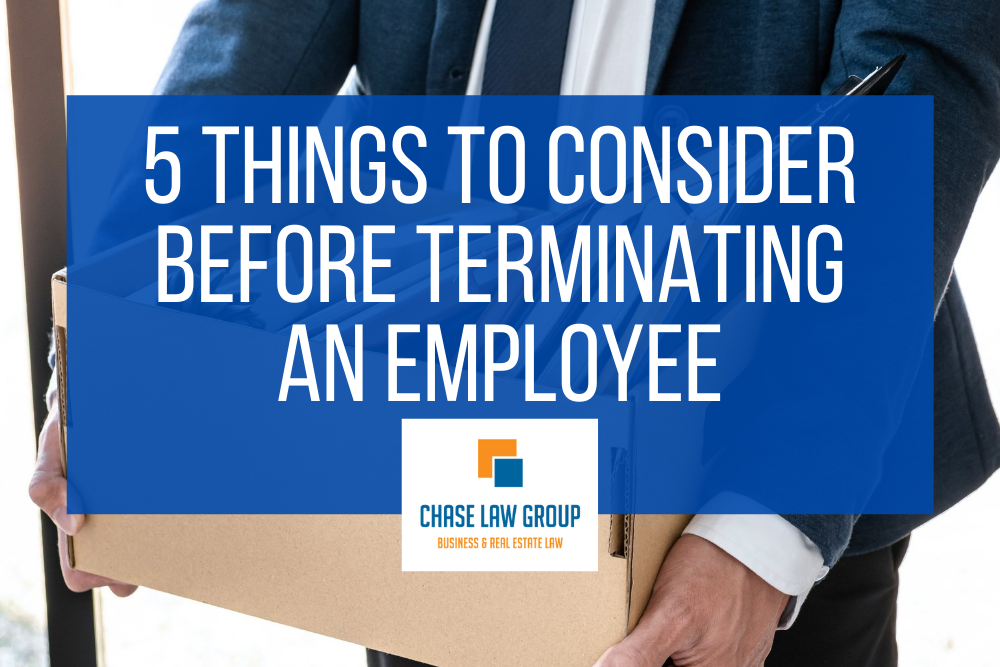Five Important Considerations Before Terminating An Employee
By Admin February 10, 2022 Category: Business Law

The decision to terminate an employee is often a difficult one. Whether due to finding a replacement, the stress and aggravation the employee situation has become, or due to the potential exposure and liability you could face if the separation is not handled correctly. However, by ensuring that you have taken into consideration 5 important issues when making the termination decision, you can proceed with the separation, in a fair and consistent manner which best protects your organization.
- Is the Decision Justified and Not A surprise to the employee?
To protect the organization as well as to avoid turnover whenever possible, it’s important that you first consider whether the separation is based upon a legitimate and justifiable reason and that it is not a surprise to the employee. First, ideally the decision is based upon a rule or policy that has been communicated to the employee in the past. Being able to refer to the rule or policy or prior discussion will support the termination and ensure that it is perceived as being legitimate and not coming out of left field. Not only will this help protect the company from a potential claim, but also will help with the company morale, as employees remaining with the company will know and understand that the company follows its own policies and treats its employees fairly. Additionally, it’s important to assess how you handled a similar employee performance issue in the past. For example, was that employee warned or notified about the rule or concern before whether verbally, in writing, or in the employee handbook or policies? By ensuring that you are treating all your employees in a similar fashion as best as possible, and in turn to avoid potential discrimination claims, take a moment and look at your past practices and confirm you can claim consistency in in its application.
- Has the Employee Recently Raised An Issue of Concern Related to the Workplace?
An important consideration regarding whether to terminate an employee is whether they have recently raised concerns related to the terms and conditions of their job or within the work place. If they have, and the concerns are based upon a state or federal law, then they could potentially show that based upon the proximity of time between their reporting any issue of concern and their separation, they have a claim against the company for wrongful termination in violation of public policy or Labor Code section 1102.5 which protects whistleblowers in the work place. Although the mere fact that there is proximity of time between their reported concern and termination, can give rise to a viable claim, it is still possible to separate the employee without exposure. If you are uncertain whether the concern previously raised by the employee could give rise to a claim of wrongful termination, consult with an employment attorney.
- Documentation
Of course any time a separation is going to take place, employers are best positioned if they can show that the employee was previously warned about their performance or conduct previously. Ideally this is done in writing, either through the use of performance reviews or documented warnings. Although the absence of documentation does not necessarily preclude the possibility of termination, a company is best positioned and protected if it can show in writing that an employee has previously been counseled or warned about the very subject for which they are now being terminated.
- Include a Witness When Communicating The Termination Decision
Whenever possible it is helpful to have a witness present in the termination meeting. Ideally and preferably, the witness should be someone superior to the employee or in an independent position. This typically would include he supervisor and the Human Resources representative. If you have no Human Resources representative, then another supervisor or executive of the company will also work. Notes should be kept after the termination meeting to confirm what was discussed, and then a follow up written communication/letter should be provided to the employee either by mail or email so that the company’s termination is clear and confirmed in writing. Also be sure that the employee’s final check including any accrued vacation or PTO is issued to the employee on the date of termination as required by California law.
- Take Steps to Protect the Company From A Departing Employee
The final consideration when terminating an employee is to ensure that the company is protected as and once the employee departs. This includes ensuring that all company property is returned to the company the employee and that their access to company software and social media is terminated. If the employee is allowed to go back to their desk to remove their personal items, be sure that someone accompanies them to avoid any disagreement concerning what they may take with them. Additionally, a letter should be issued (which can be the same letter issued to the employee regarding their separation) reminding the employee of their obligations under any applicable proprietary information agreement or policy.
By taking into account these 5 considerations, employers can better establish that the termination was appropriate both to the terminated employee as well as those that remain with the company. Additionally, whenever possible consult with experienced employment counsel to discuss the separation in advance of proceeding, to ensure you are following the law and limiting the company’s exposure. If you have any questions regarding terminations or have other employment related legal concerns, contact our employment attorney, Scott Liner at [email protected].

